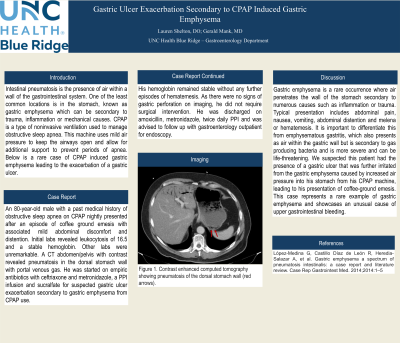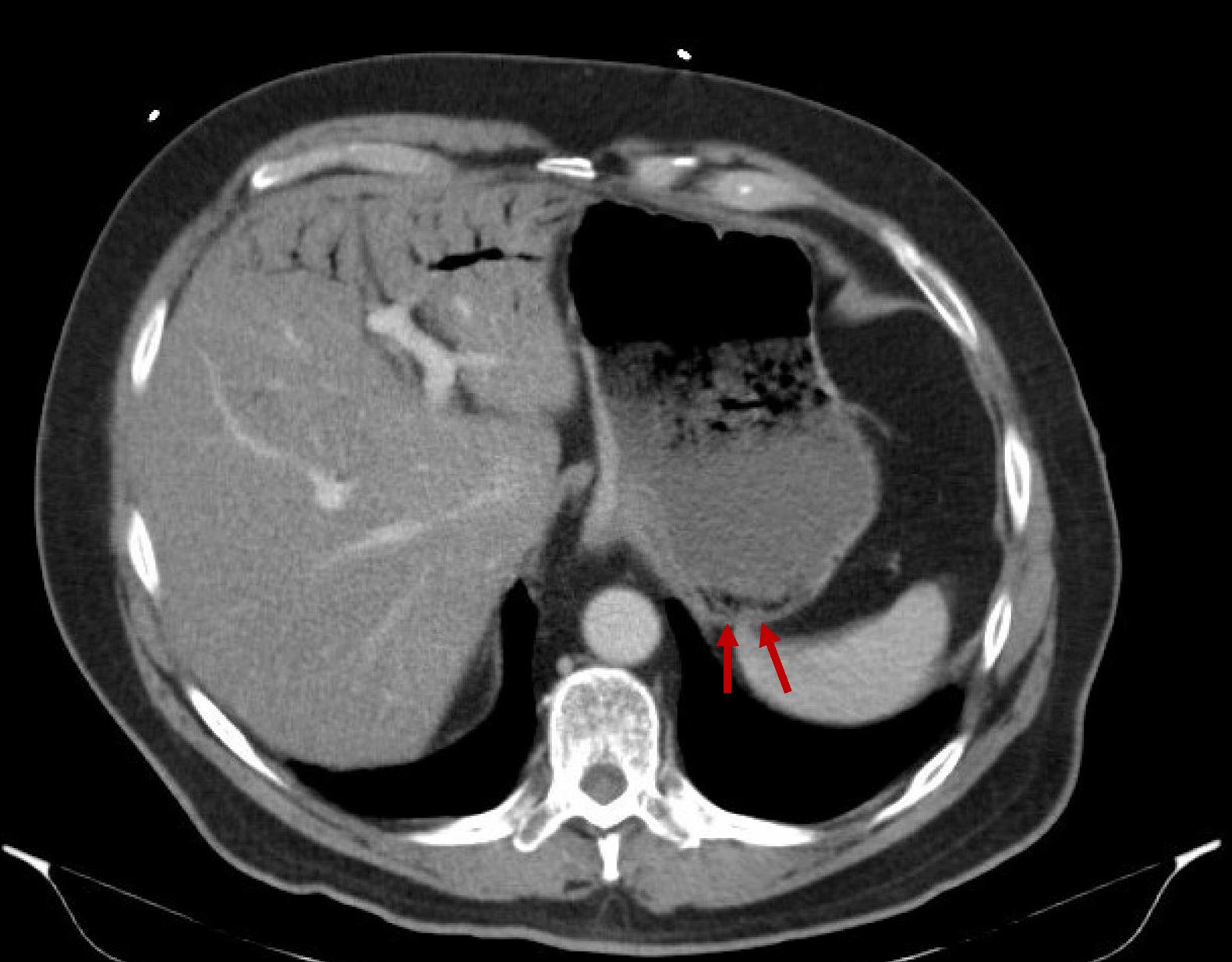Tuesday Poster Session
Category: Stomach
P5074 - Gastric Ulcer Exacerbation Secondary to CPAP Induced Gastric Emphysema
Tuesday, October 29, 2024
10:30 AM - 4:00 PM ET
Location: Exhibit Hall E

Has Audio

Lauren Shelton, DO
UNC Health Blue Ridge
Morganton, NC
Presenting Author(s)
Lauren Shelton, DO, Gerald Mank, MD
UNC Health Blue Ridge, Morganton, NC
Introduction: Intestinal pneumatosis is the presence of air within a wall of the gastrointestinal system. One of the least common locations is in the stomach, known as gastric emphysema which can be secondary to trauma, inflammation or mechanical causes. CPAP is a type of noninvasive ventilation used to manage obstructive sleep apnea. The machine uses mild air pressure to keep the airways open and allow for additional support to prevent periods of apnea. Below is a rare case of CPAP induced gastric emphysema leading to the exacerbation of a gastric ulcer.
Case Description/Methods: An 80-year-old male with a past medical history of obstructive sleep apnea on CPAP nightly presented after an episode of coffee ground emesis with associated mild abdominal discomfort and distension. Initial labs revealed leukocytosis of 16.5 and a stable hemoglobin. Other labs were unremarkable. A CT abdomen/pelvis with contrast revealed pneumatosis in the dorsal stomach wall with portal venous gas. He was started on empiric antibiotics with ceftriaxone and metronidazole, a PPI infusion and sucralfate for suspected gastric ulcer exacerbation secondary to gastric emphysema from CPAP use. His hemoglobin remained stable without any further episodes of hematemesis. As there were no signs of gastric perforation on imaging, he did not require surgical intervention. He was discharged on amoxicillin, metronidazole, twice daily PPI and was advised to follow up with gastroenterology outpatient for endoscopy.
Discussion: Gastric emphysema is a rare occurrence where air penetrates the wall of the stomach secondary to numerous causes such as inflammation or trauma. Typical presentation includes abdominal pain, nausea, vomiting, abdominal distention and melena or hematemesis. It is important to differentiate this from emphysematous gastritis, which also presents as air within the gastric wall but is secondary to gas producing bacteria and is more severe and can be life-threatening. We suspect this patient had the presence of a gastric ulcer that was further irritated from the gastric emphysema caused by increased air pressure into his stomach from his CPAP machine, leading to his presentation of coffee-ground emesis. This case represents a rare example of gastric emphysema and showcases an unusual cause of upper gastrointestinal bleeding.
López-Medina G, Castillo Díaz de León R, Heredia-Salazar A, et al. Gastric emphysema a spectrum of pneumatosis intestinalis: a case report and literature review. Case Rep Gastrointest Med. 2014;2014:1–5

Disclosures:
Lauren Shelton, DO, Gerald Mank, MD. P5074 - Gastric Ulcer Exacerbation Secondary to CPAP Induced Gastric Emphysema, ACG 2024 Annual Scientific Meeting Abstracts. Philadelphia, PA: American College of Gastroenterology.
UNC Health Blue Ridge, Morganton, NC
Introduction: Intestinal pneumatosis is the presence of air within a wall of the gastrointestinal system. One of the least common locations is in the stomach, known as gastric emphysema which can be secondary to trauma, inflammation or mechanical causes. CPAP is a type of noninvasive ventilation used to manage obstructive sleep apnea. The machine uses mild air pressure to keep the airways open and allow for additional support to prevent periods of apnea. Below is a rare case of CPAP induced gastric emphysema leading to the exacerbation of a gastric ulcer.
Case Description/Methods: An 80-year-old male with a past medical history of obstructive sleep apnea on CPAP nightly presented after an episode of coffee ground emesis with associated mild abdominal discomfort and distension. Initial labs revealed leukocytosis of 16.5 and a stable hemoglobin. Other labs were unremarkable. A CT abdomen/pelvis with contrast revealed pneumatosis in the dorsal stomach wall with portal venous gas. He was started on empiric antibiotics with ceftriaxone and metronidazole, a PPI infusion and sucralfate for suspected gastric ulcer exacerbation secondary to gastric emphysema from CPAP use. His hemoglobin remained stable without any further episodes of hematemesis. As there were no signs of gastric perforation on imaging, he did not require surgical intervention. He was discharged on amoxicillin, metronidazole, twice daily PPI and was advised to follow up with gastroenterology outpatient for endoscopy.
Discussion: Gastric emphysema is a rare occurrence where air penetrates the wall of the stomach secondary to numerous causes such as inflammation or trauma. Typical presentation includes abdominal pain, nausea, vomiting, abdominal distention and melena or hematemesis. It is important to differentiate this from emphysematous gastritis, which also presents as air within the gastric wall but is secondary to gas producing bacteria and is more severe and can be life-threatening. We suspect this patient had the presence of a gastric ulcer that was further irritated from the gastric emphysema caused by increased air pressure into his stomach from his CPAP machine, leading to his presentation of coffee-ground emesis. This case represents a rare example of gastric emphysema and showcases an unusual cause of upper gastrointestinal bleeding.
López-Medina G, Castillo Díaz de León R, Heredia-Salazar A, et al. Gastric emphysema a spectrum of pneumatosis intestinalis: a case report and literature review. Case Rep Gastrointest Med. 2014;2014:1–5

Figure: Contrast enhanced computed tomography showing pneumatosis of the dorsal stomach wall (red arrows).
Disclosures:
Lauren Shelton indicated no relevant financial relationships.
Gerald Mank indicated no relevant financial relationships.
Lauren Shelton, DO, Gerald Mank, MD. P5074 - Gastric Ulcer Exacerbation Secondary to CPAP Induced Gastric Emphysema, ACG 2024 Annual Scientific Meeting Abstracts. Philadelphia, PA: American College of Gastroenterology.
